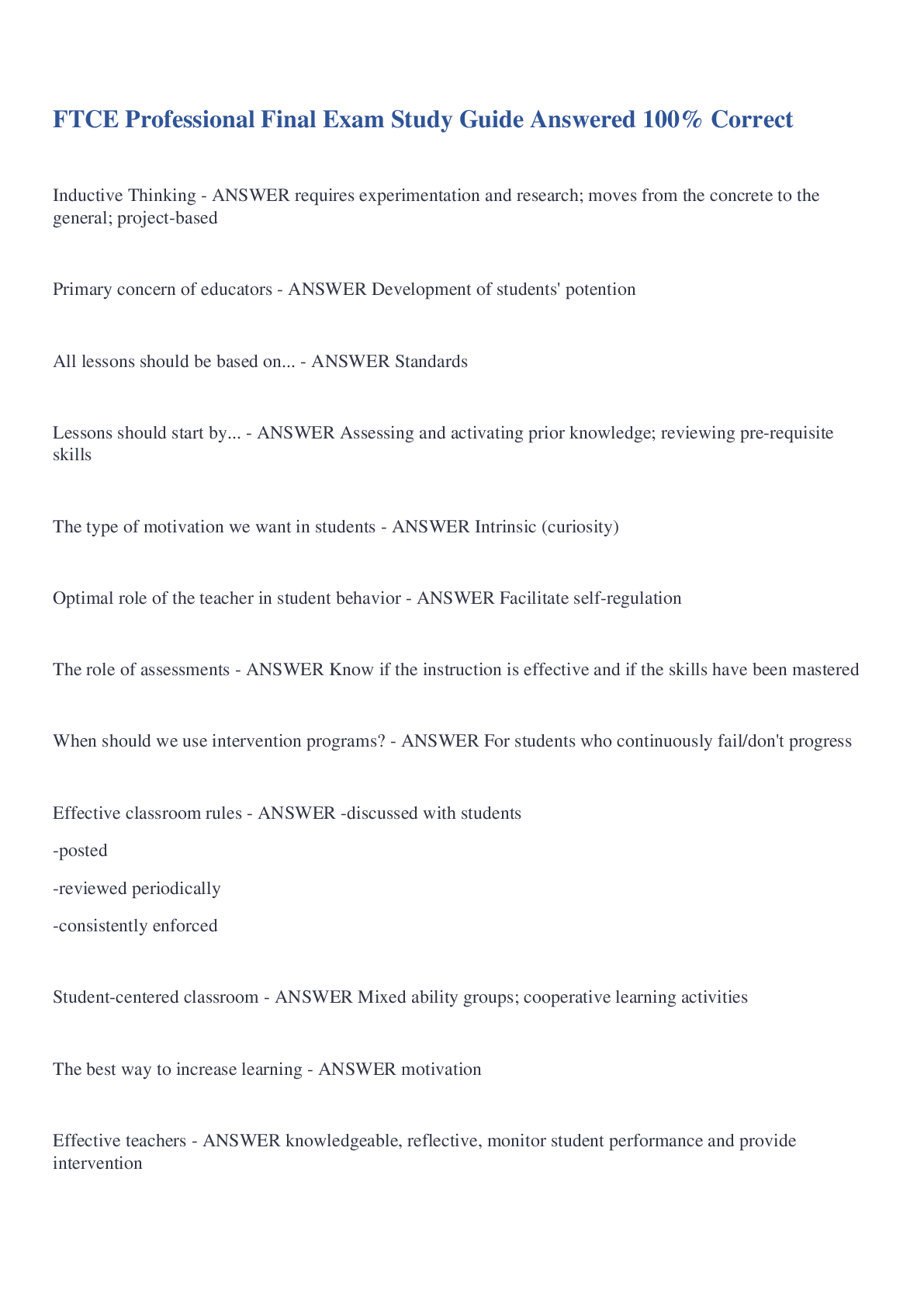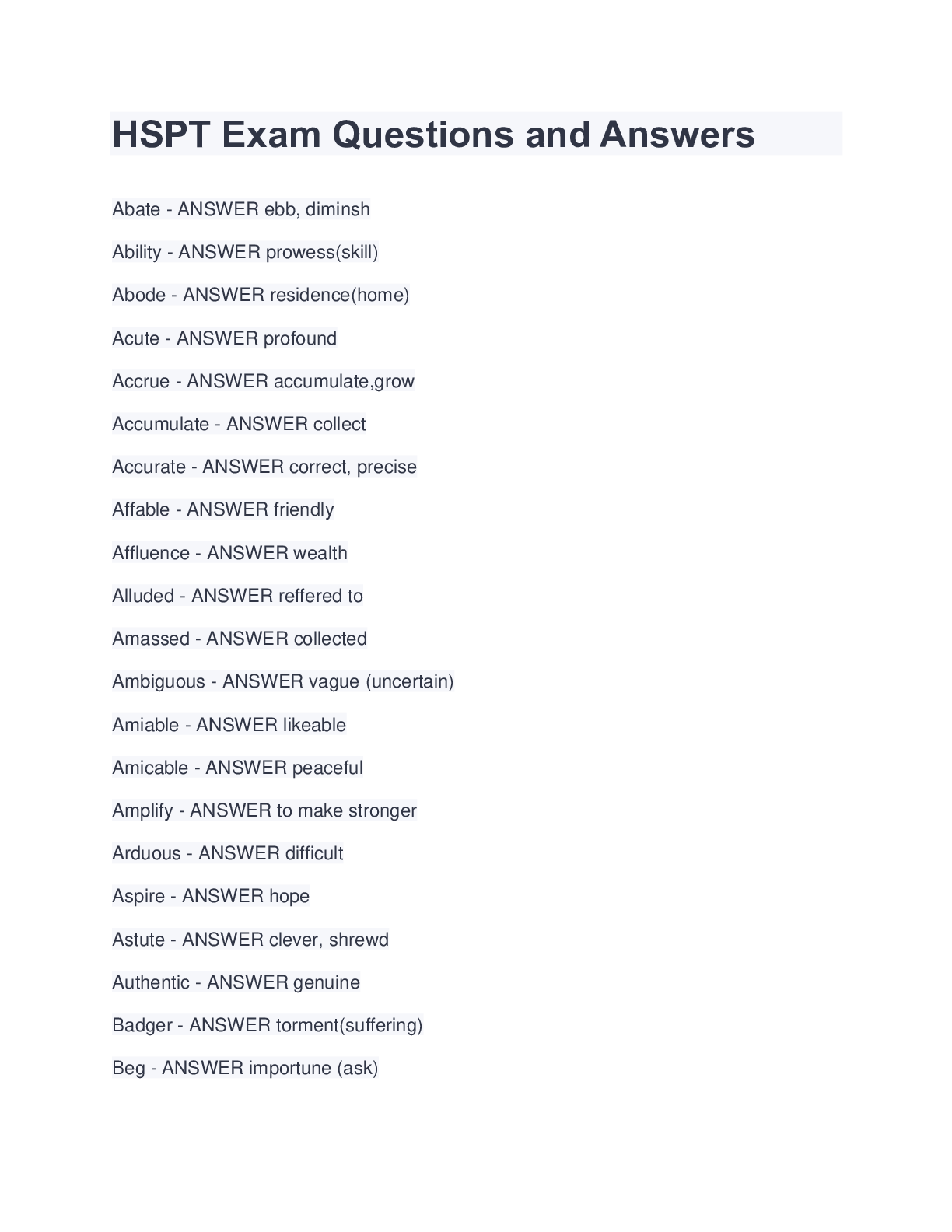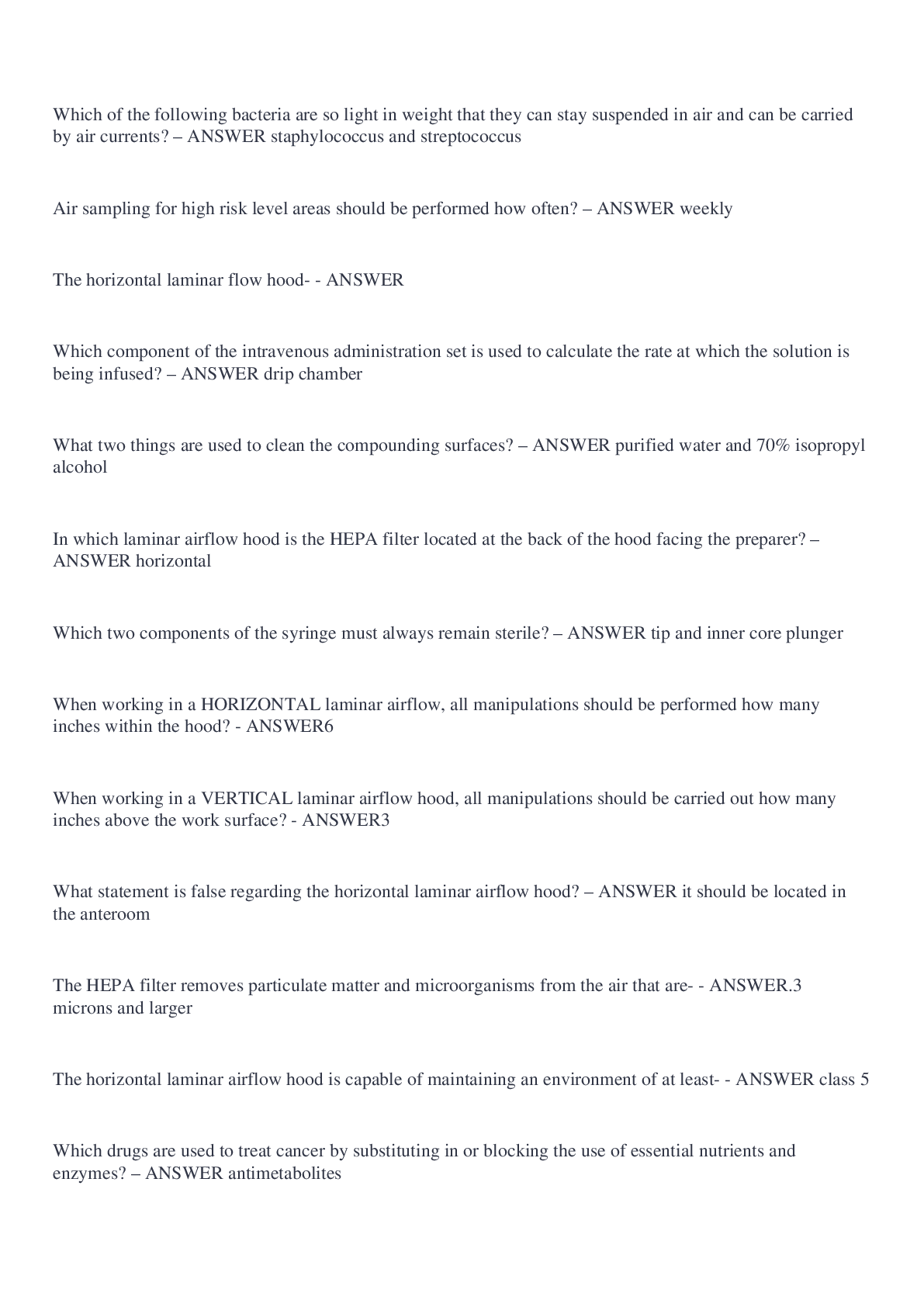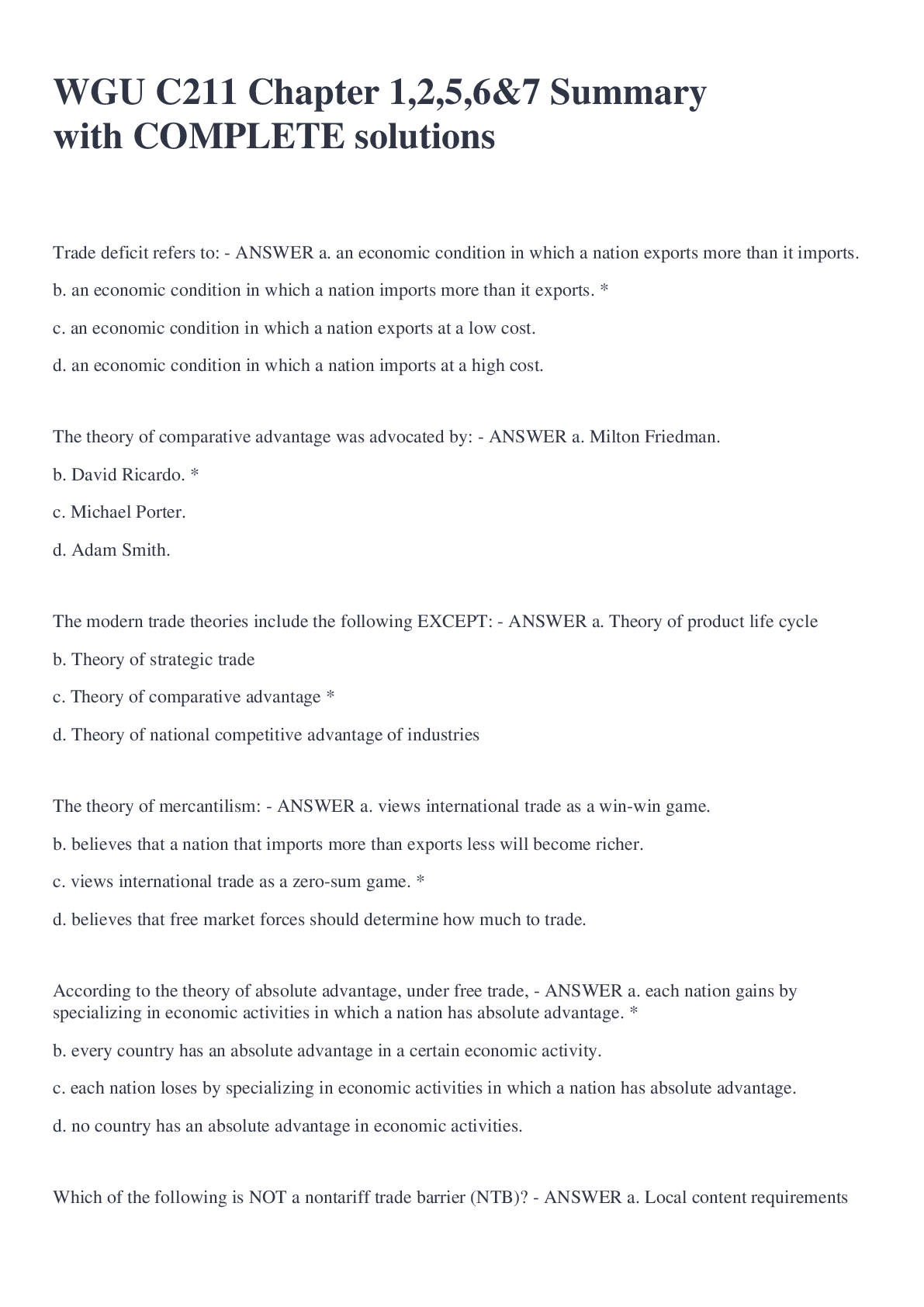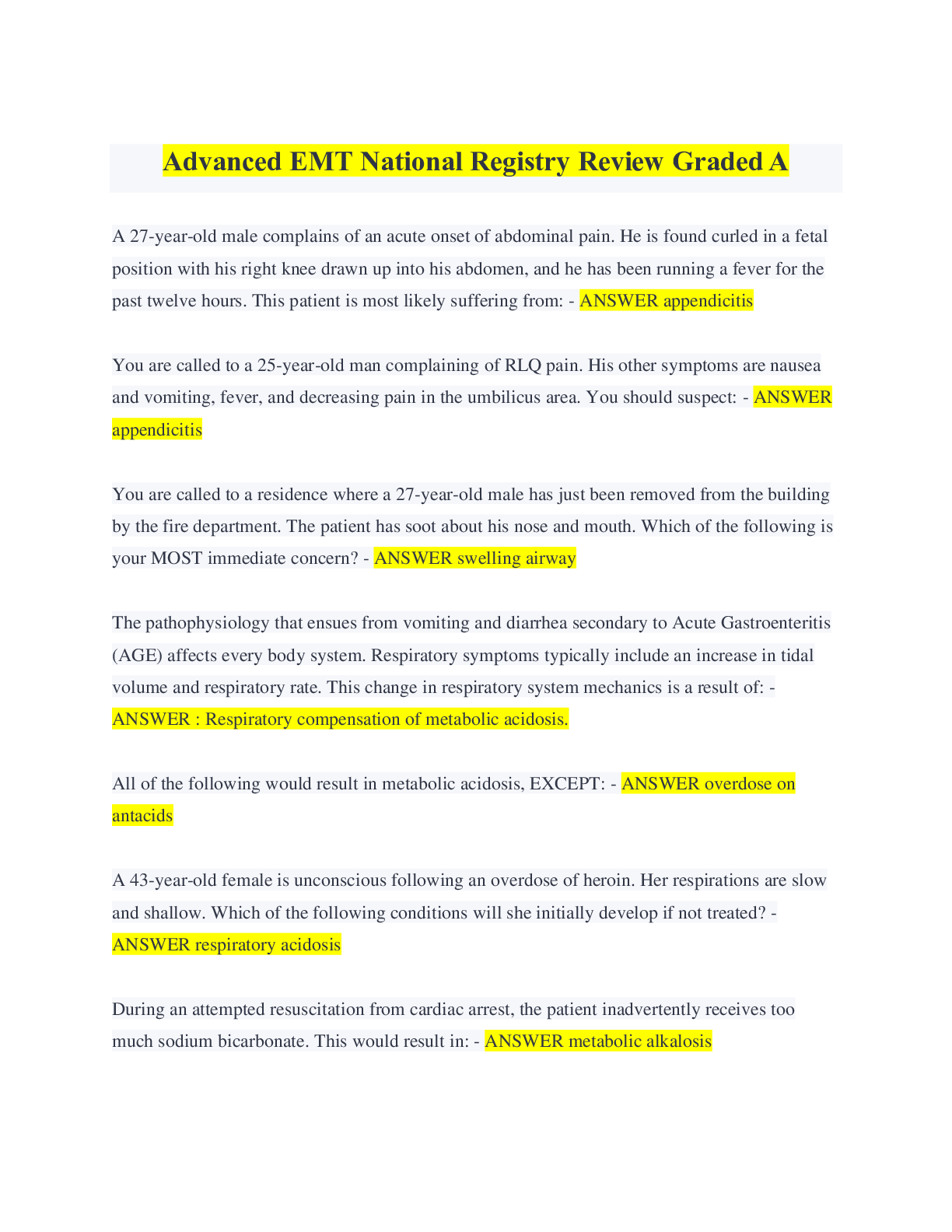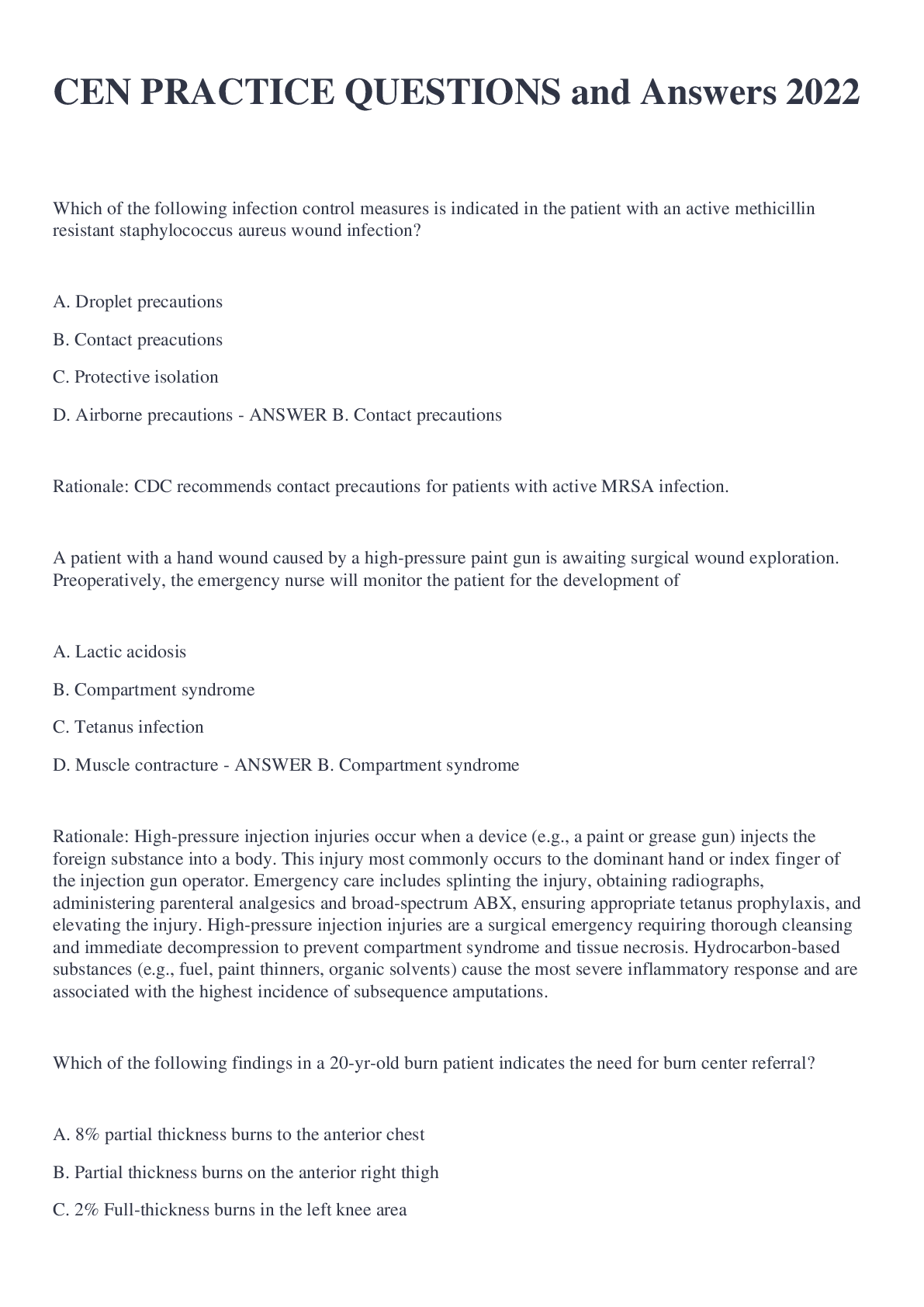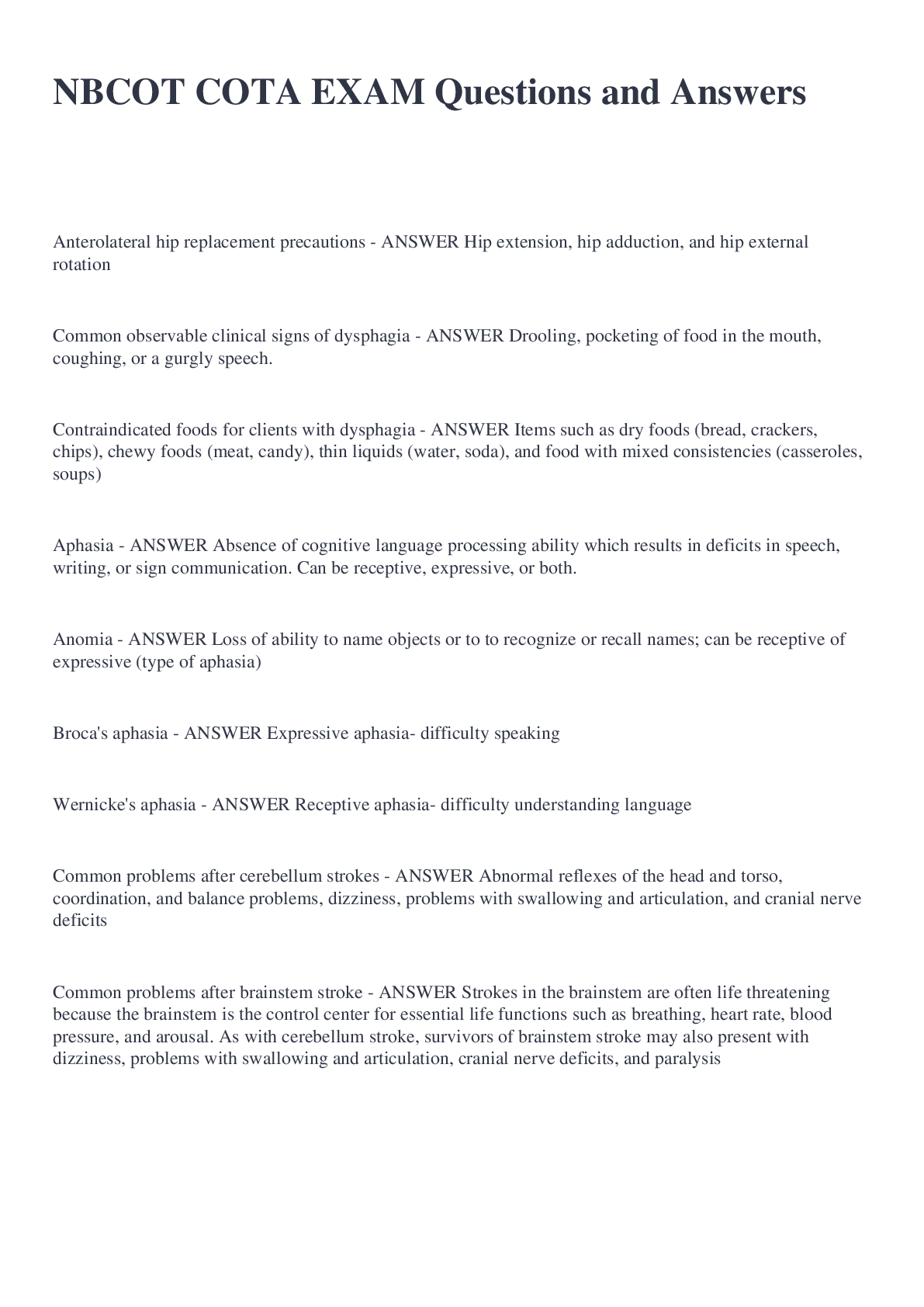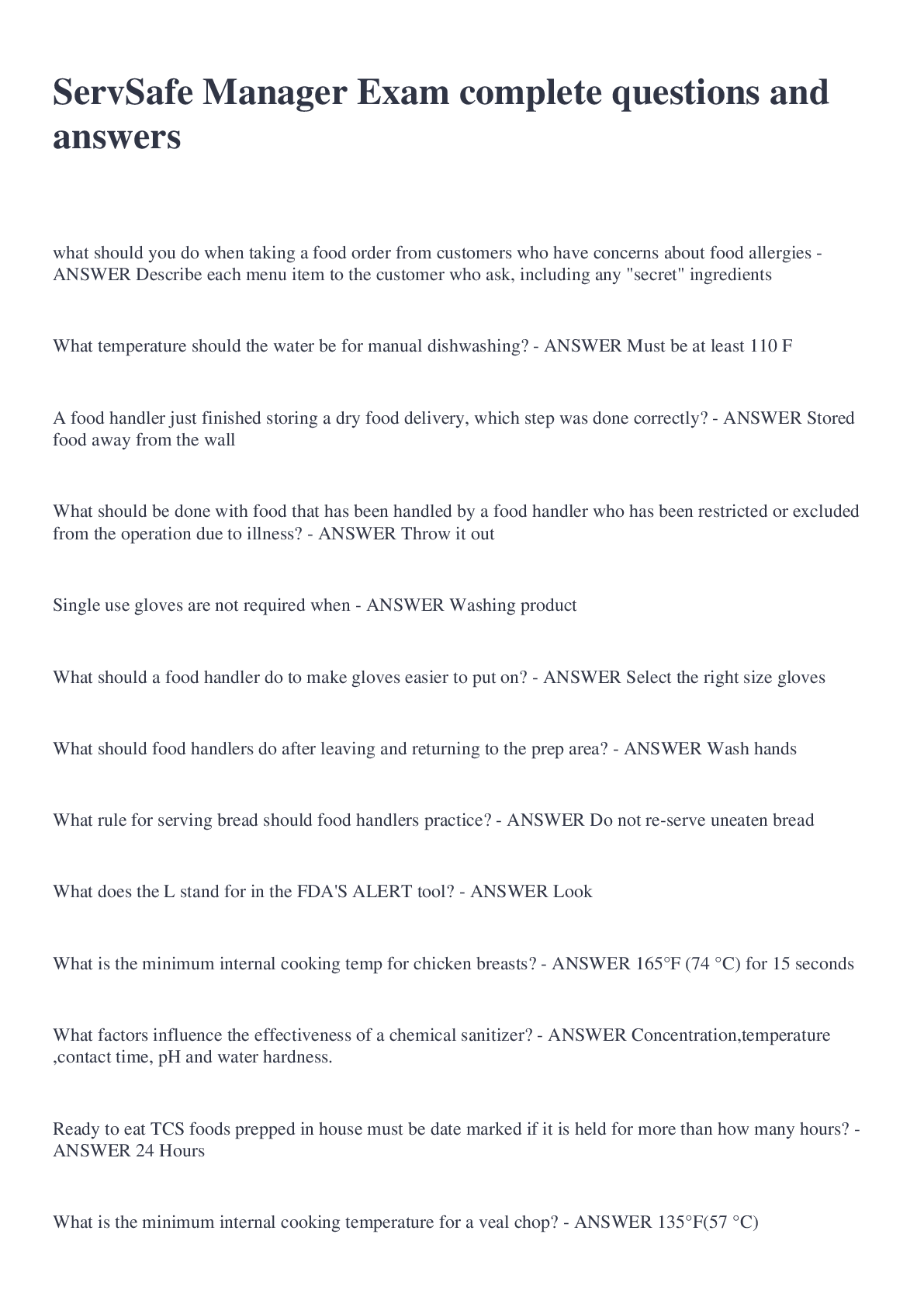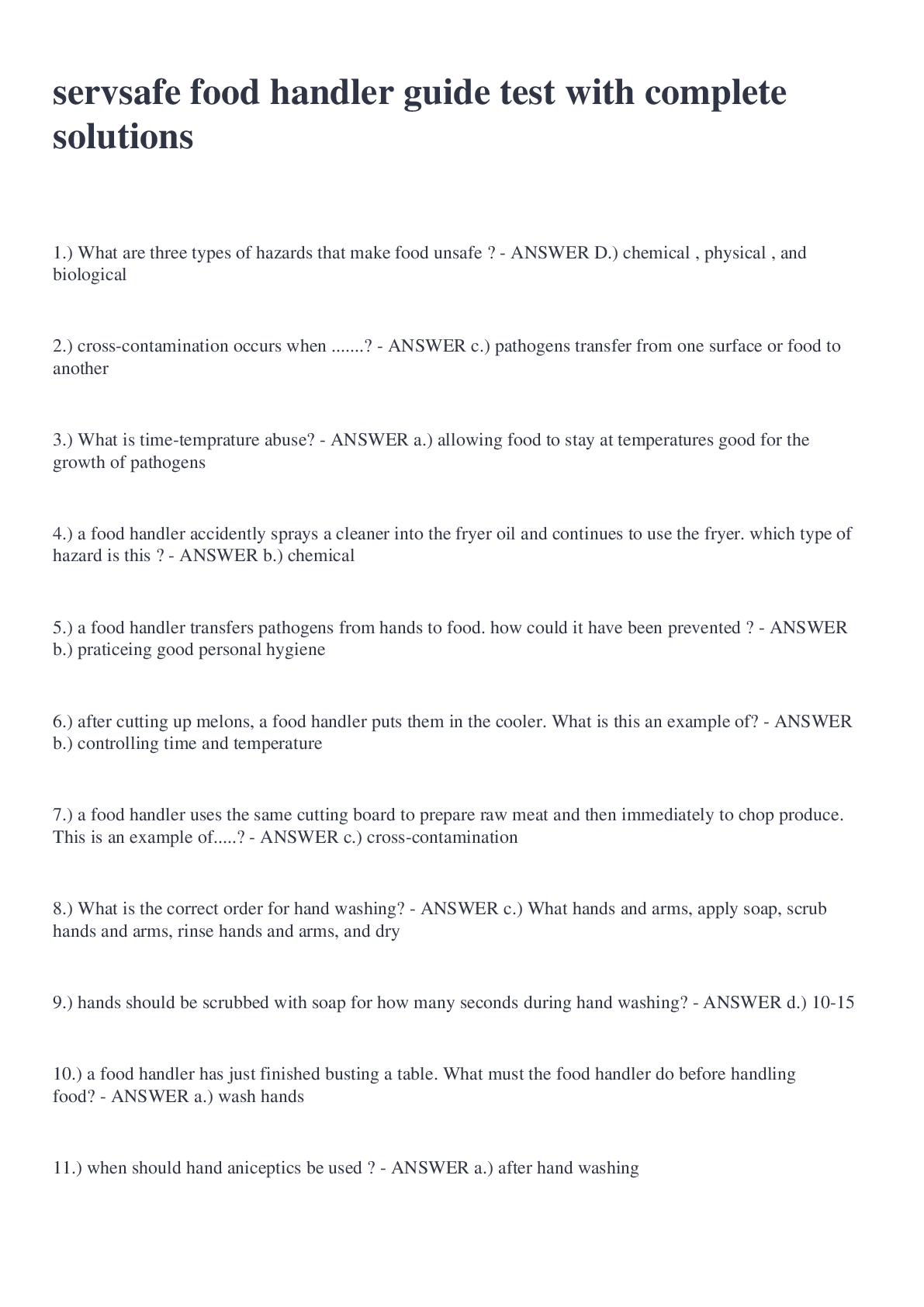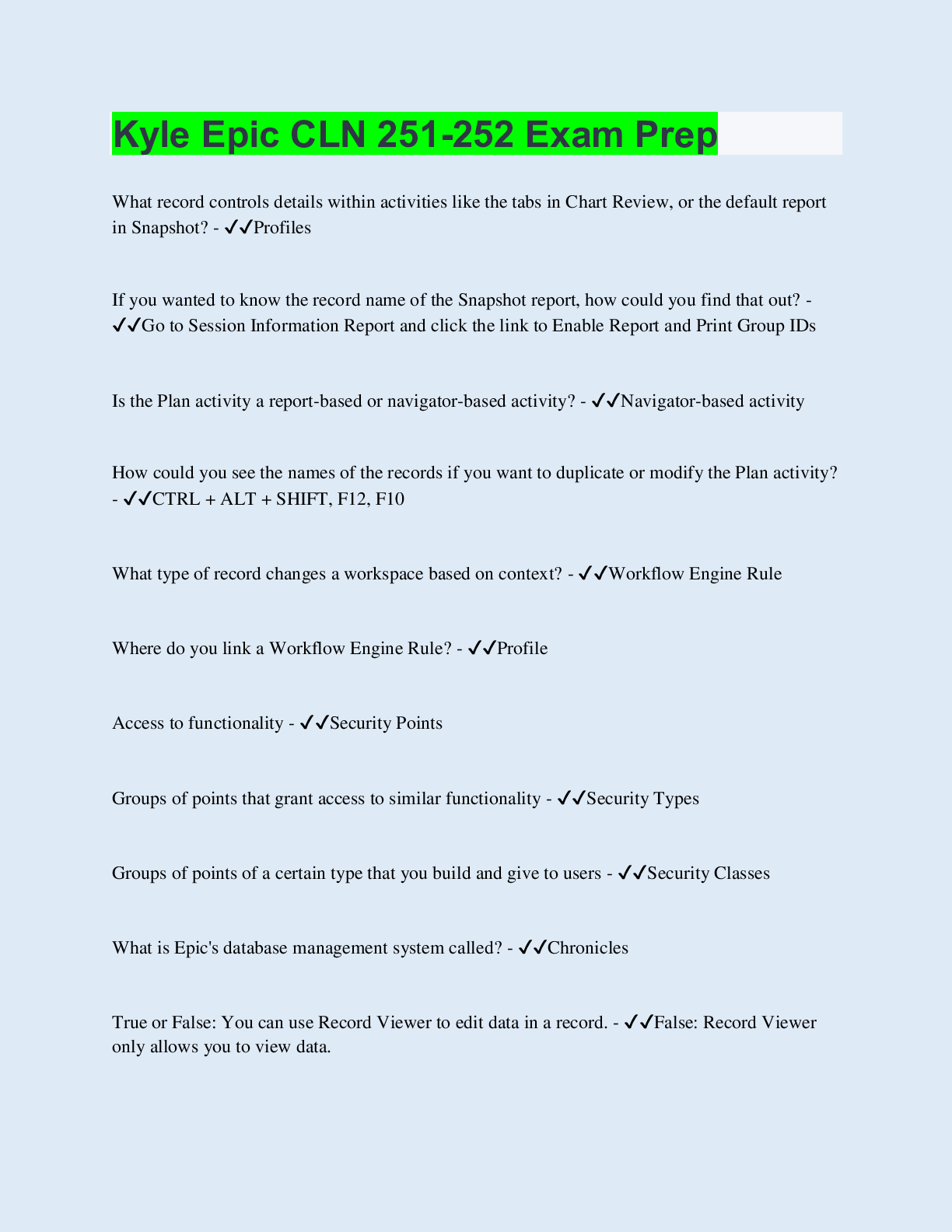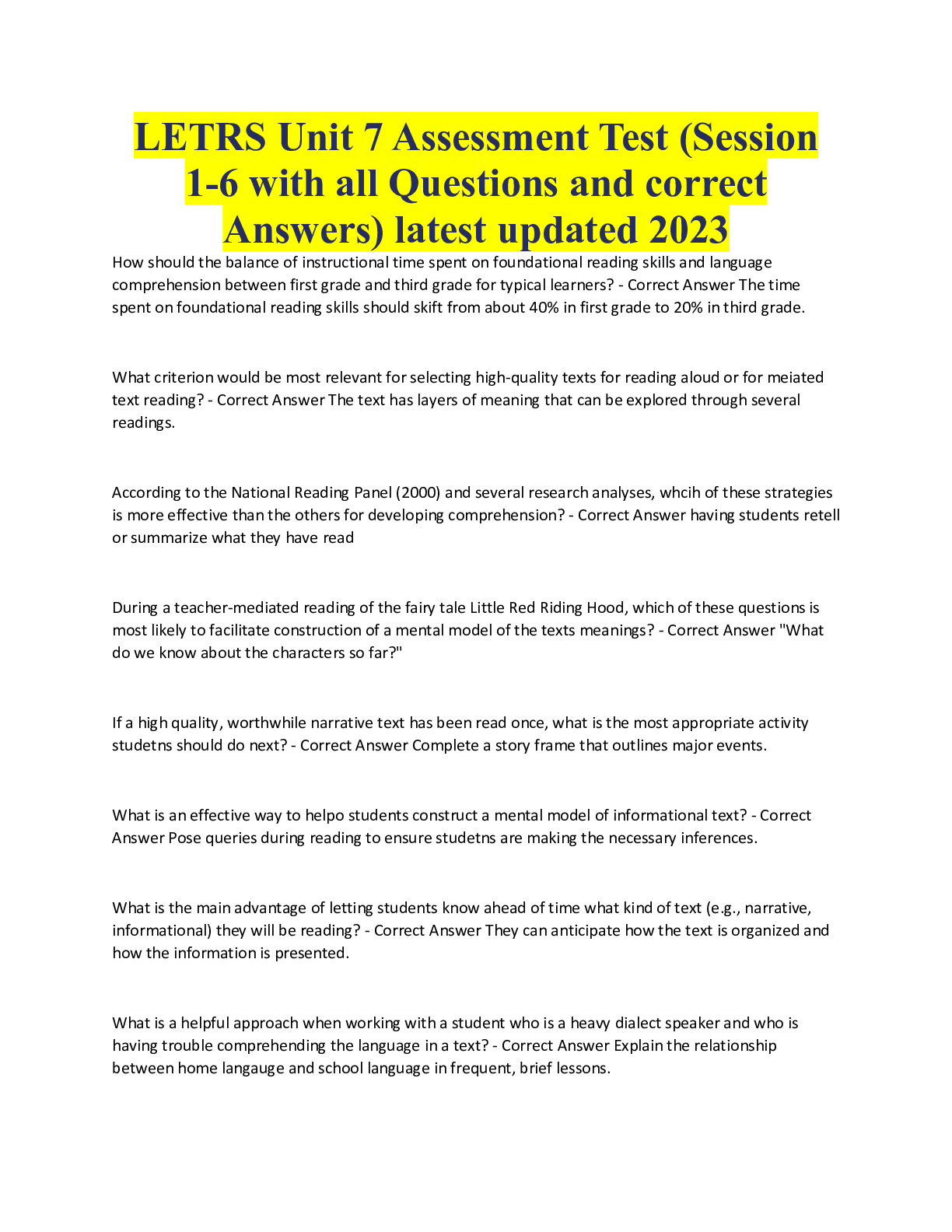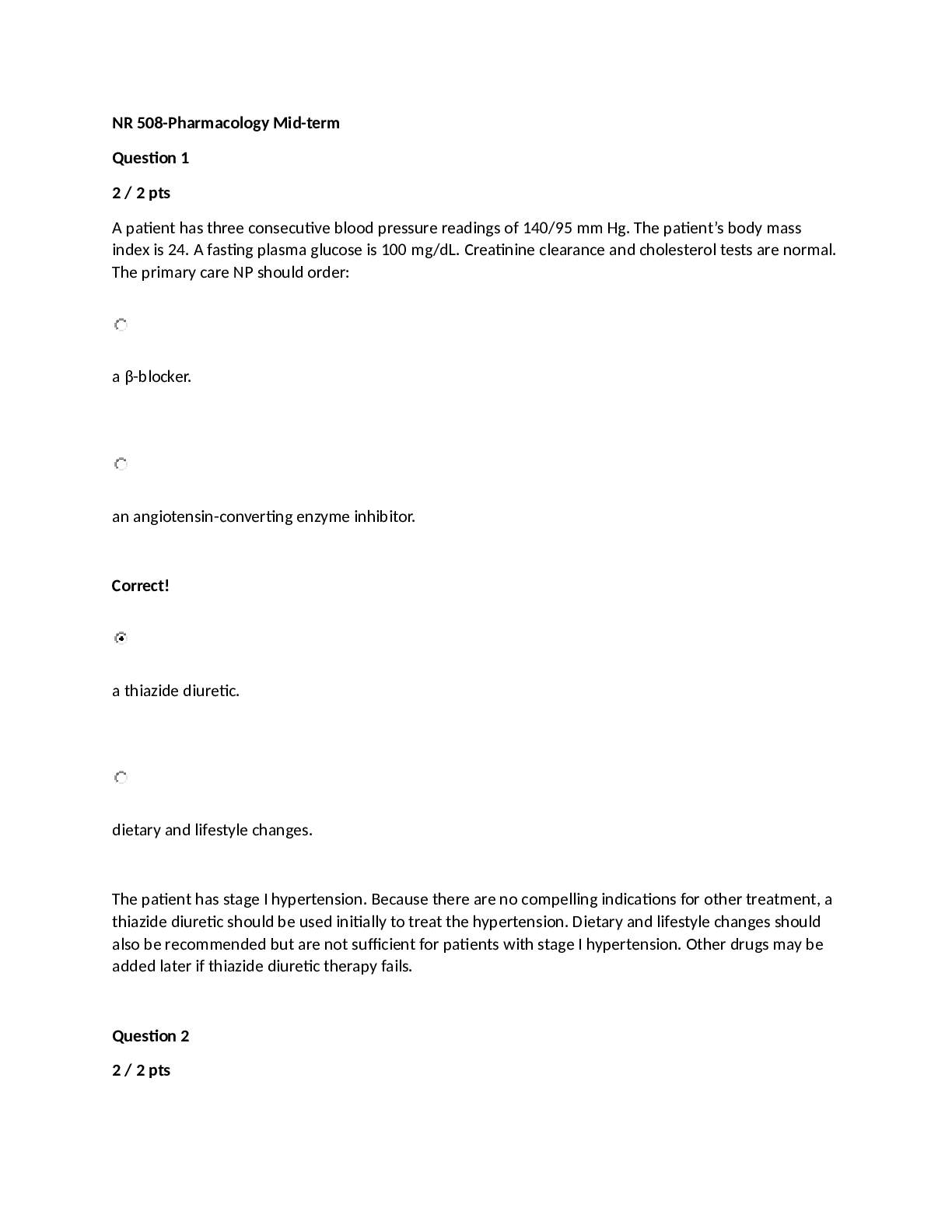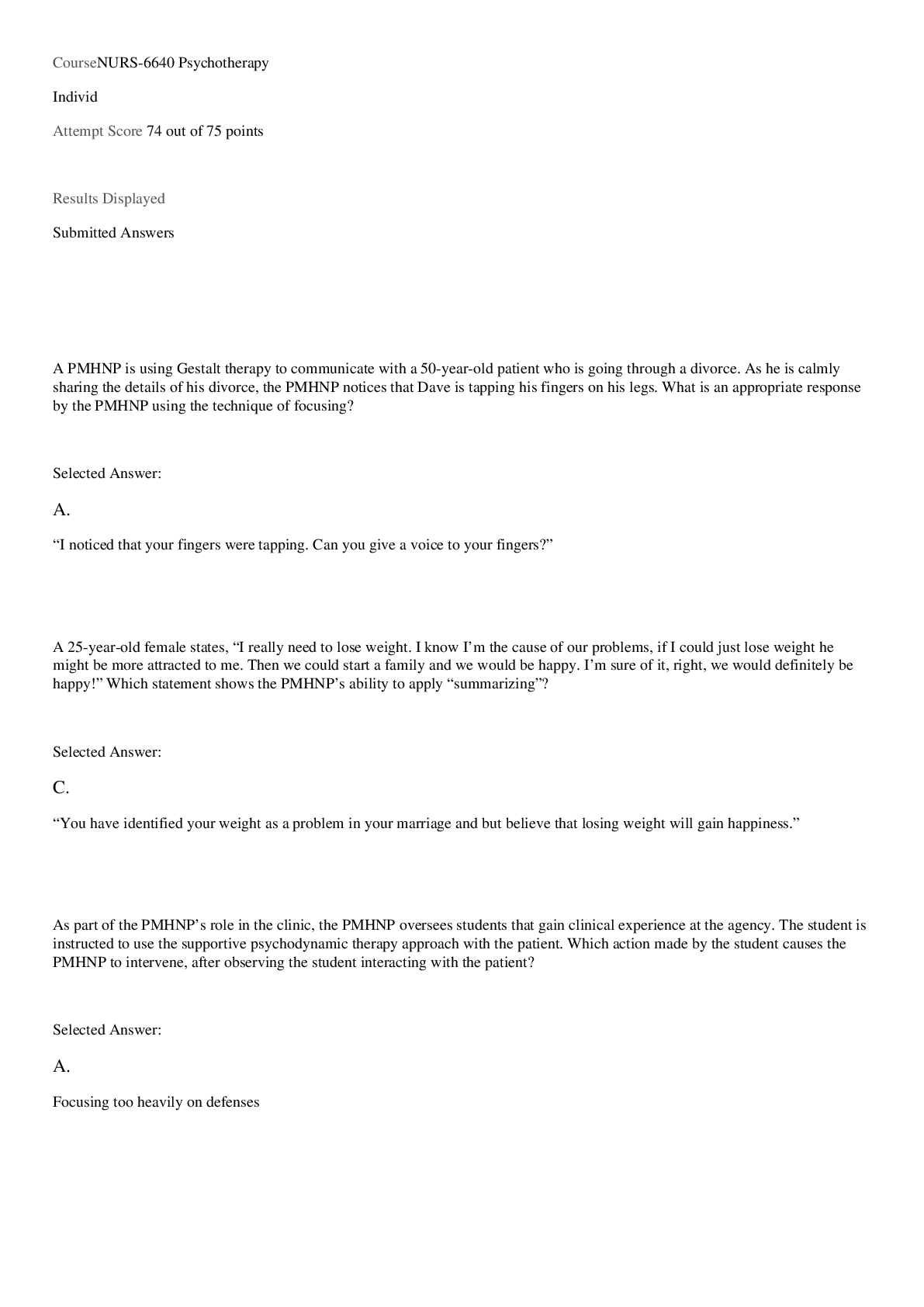Advanced Pharmacology Exam Questions with correct Answers
Document Content and Description Below
Explain Pharmacokinetics - ANSWER The study of how drugs are moved through the body and are encompassed in mechanisms of: Absorption Distribution Metabolism Excretion Think Kinetic (movement)... Pharmacodynamics - ANSWER study of the biochemical and physiologic effects of drugs on the body Think Dynamic (change) majority of drugs either (a) mimic or inhibit normal physiological/biochemical processes or inhibit pathological processes in animals or (b) inhibit vital processes of endo- or ectoparasites and microbial organisms Summarize the main drug actions - ANSWER 1 - stimulating action through direct receptor agonism and downstream effects 2 - depressing action through direct receptor agonism and downstream effects (ex.: inverse agonist) 3- blocking/antagonizing action (as with silent antagonists), the drug binds the receptor but does not activate it 4- stabilizing action, the drug seems to act neither as a stimulant or as a depressant 5- exchanging/replacing substances or accumulating them to form a reserve (ex.: glycogen storage) Desired activity is achieved through what main mechanisms? - ANSWER -Cellular membrane disruption -Chemical reaction with downstream effects -Interaction with enzyme proteins -Interaction with structural proteins -Interaction with carrier proteins -Interaction with ion channels -Ligand binding to receptors: 1)Hormone receptors 2) Neuromodulator receptors 3)Neurotransmitter receptors Explain the therapeutic window - ANSWER therapeutic window is the amount of a medication between the amount that gives an effect (effective dose) and the amount that gives more adverse effects than desired effects Duration of action - ANSWER duration of action of a drug is the length of time that particular drug is effective Explain bioavailability - ANSWER drug's bioavailability can be defined as the proportion of the drug that reaches its site of action 6 rights to medication administration - ANSWER RIGHT CLIENT RIGHT MEDICATION RIGHT DOSAGE RIGHT ROUTE RIGHT TIME RIGHT DOCUMENTATION Potency - ANSWER potency is a measure of drug activity expressed in terms of the amount required to produce an effect of given intensity (more morphine is needed to give the same effects as fentanyl) Efficacy - ANSWER Efficacy is the relationship between receptor occupancy and the ability to initiate a response at the molecular, cellular, tissue or system level. In other words, efficacy refers to how well an action is took after the drug is bound to a receptor Affinity - ANSWER Affinity is how well a drug can bind to a receptor (Fast/strong binding = higher affinity) Benzodiazepine MOA - ANSWER Act on GABA which is a major inhibitory NTM in the CNS; Effects are produced by interacting with a protein complex with in the neuronal membrane GABA which has a high 'affinity' for benzo's specifically; Inhibition of polysynaptic afferent pathways resulting in skeletal muscle relaxation; It decreases the spread of seizure activity due to an increased pre-synaptic inhibition of the CNS Benzodiazepine uses/indications - ANSWER Similar actions however different doses/concentrations/combinations produce different actions thus have different uses Anxiety/panic disorders skeletal muscle relaxation seizures sedation for procedures (due to relaxation and amnesic properties) Benzodiazepines adverse effects - ANSWER Most derived through CNS actions; Ataxia, dizziness, drowsiness/sedation, blurred vision, hypnosis, weakness, fatigue More severe: hypersensitivity, mental depression, hypotension, paradoxical stimulation, rebound seizures Benzo pharmacokinetics - ANSWER Widely distributed throughout the body accumulate in lipid rich areas (CNS and adipose tissue) the more lipophilic the agent the faster it is absorbed Onset 30 min- 1 hr lasting 4-6 hours, peak at 1-2 hours IV Admin: onset 1-5 min, peak immediately, last 15-20 min metabolized by the liver and excreted in urine Beta blocker (BB) MOA - ANSWER Interrupts the nerve impulses across the neurons by antagonizing the receptors with in the cardiac cells resulting in blockade of the beta 1 receptors'; -B1 blockade results in reduction of heart rate (chronotropic), rate of conduction through the AV node (dromotropic), and force of contraction (inotropic) This in turn decreases the oxygen demand on the myocytes, reduction in BP from the reduced HR and inotropic actions Hypoglycemia can occur with beta blockade because β2-adrenoceptors normally stimulate glycogen breakdown (glycogenolysis) in the liver and pancreatic release of the hormone glucagon, which work together to increase plasma glucose Beta blocker Therapeutic uses - ANSWER Useful in angina, HTN, cardiac dysrhythmias, MI, HF, Hyperthyroidism, migraines, pheochromocytoma, Glaucoma In angina/MI: reduction of oxygen demand HTN: B1 blockade as well as suppressed renin release via B1 blockade in the kidneys shows a marked decrease in PVR which results in improved stroke volume Beta Blocker Adverse effects - ANSWER B1 blockade: bradycardia resulting in reduced CO and precipitating HF, AV heart block, Rebound cardiac Excitability B2 effects incl: bronchoconstriction, and Inhibition of glycogenolysis resulting in hypoglycemia Beta blocker Pharacokinetics - ANSWER Highly lipid soluble Absorption usually rapid/complete 50% 1st pass metabolism peak concentrations approx. 1.5-2 hours, onset about 4-5 hrs liver metabolized, renal excretion as a metabolite Beta blocker interactions - ANSWER Calcium channel blockers: Negative Ino/dromo/chronotropic effects anti-arrhythmics: may enhance their effects leading to unwated outcomes Nitrates: may potentiate hypotensive effects MAO inhibitors: may increase reduction of sympathetic activity thus the inability to respond to Fight/flight mechanism resulting in reduced BP/HR overall Digitalis: Can potentiate suppressed AV conduction Calcium Channel Blockers (CCB) MOA - ANSWER inhibition of calcium movement in smooth and cardiac muscle tissue by selectively antagonizing calcium influx movment across the cellular membrane responsible for smooth/cardiac muscle conduction velocity: produces relaxation of coronary smooth muscles, dilation of coronary arteries; reduced dromotropic effects of the sa/av node and reduced automaticity Effects peripherally result in vasodilation through smooth muscle relaxation Different agents have different effects on different receptors within the transmembrane calcium channels Non specific effects in blood coagulation by inhibiting platelet aggregation in the clotting cascade CCB indications - ANSWER Hypertension, angina, dysrhythmias CCB Adverse effects - ANSWER Peripheral edema, flushing, palpitations, headache Pulmonary edema, rebound tachycardia, bradycardia, skin rash CCB drug interactions - ANSWER BB and other antiarrhythmics can potentiate their effects increased concentrations of theophyliine and digoxin may occur Non-depolarizing Neuromuscular Blocker MOA - ANSWER Prevent Ach from activating Nicotinic 'm' receptors on skeletal muscle, causing relaxation and flaccidity (does not cause depolarization at the neuromuscular endplate) Competes with Ach for biding with Nm receptors, blocking Ach thus preventing stimulation causing the muscle to no longer be engaged and relax; effect lasts until there is insufficient amount available to overtake the Ach (muscles paralyze at different times: Levator muscles of the eyelids first, than limbs, abdomen, and lastly the glottis diaphragm and intercostal) Non-depolarizing Neuromuscular Blocker indications - ANSWER To facilitate muscular relaxation for general procedures requiring its purose such as to facilitate ETI, Mechanical ventilation, Surgery Non-depolarizing Neuromuscular Blocker Adverse effects - ANSWER Hypotension: is due to release of histamine from mast cells and partial blockade of Nn receptors in the ANS by suppressing sympathetic tone to peripheral vasculature Myasthenia gravis: condition characterized by an overall decreased number of Nm receptors thus a Nm blocking agent given in this subset could produce a more profound, rapid, and prolonged effect Non-depolarizing Neuromuscular blocking agent drug interactions - ANSWER Hypokalemia can enhance effects Hyperkalemia can reduce effects Aminoglycoside antibiotics (gentamycin, vancamyacin), tetracycline, non PCN antibiotics: can intensive the response to Nm blockade Cholinesterase inhibitors: Decrease the effectiveness effectively reversing the Nm blockade due to an increased degredation of Ach @ the neuromuscular junction Acetylcysteine (mucomyst, pravolex) Mucolytic: MOA - ANSWER Antidote to Acetaminophen: Exact mechanism is unknown however thought to restore hepatic glutathione and thus inactivating the toxic metabolite of acetaminophen, preventing further hepatic damage Metabolite produced by acetaminophen: N-acetyl-p-benzoquinone imine (NAPQI) accumulates within the body. It is normally conjugated by glutathione, but when taken in excess, the body's glutathione reserves are not sufficient to inactivate the toxic NAPQI. This metabolite is then free to react with key hepatic enzymes, thereby damaging liver cells Acetylcysteine (mucomyst, pravolex) Mucolytic: MOA mucolytic - ANSWER acts by splitting the bonds of mucoprotein (substance responsible for increased viscosity of mucous secretions in the lungs) Acetylcysteine (mucomyst, pravolex) Mucolytic: Indications - ANSWER Acetaminophen Toxicity Mucolytic action in acute and chronic bronchopulmonary disease; Tracheostomy care Acetylcysteine (mucomyst, pravolex) Mucolytic: Dose - ANSWER Acetaminophen Toxicity: 150 mg/kg IV over 15 min Repeated at 50mg/kg over 4 hours Acetylcysteine (mucomyst, pravolex) Mucolytic: Contraindications - ANSWER HSN to drug Status asthmaticus as it may precipitate bronchospasm Activated Charcoal w sorbitol: MOA - ANSWER Absorbs ingested toxins by inhibiting their absorption in the GI tract Sorbitol is a sweetener and works as a laxative for the elimination of the poison from the body Activated Charcoal w sorbitol: Dose - ANSWER 30-100 g in 250 ml water (5-10 times the estimated weight of the drug/chemical) PO/NG/OG peds: 1-12 yo: 1 gm/kg Activated Charcoal w sorbitol: Contraindications - ANSWER Pt who has ingested corrosive agent or petroleum distillate violent pt with ALOC Altered pt and not intubated with no NG/OG in place Activated Charcoal w sorbitol: Caution - ANSWER Not effective for cyanide, mineral acids, caustic alkaloids, organic solvents, iron, ethanol, methanol, lithium Can cause vomiting and can cause severe ALI if aspirated Adenosine (adenocard) antiarrhythmic (naturally occurring nucleoside): MOA - ANSWER In the heart it acts on the AV node to slow conduction and inhibit reentry pathways mediated via the A1 receptor, inhibiting adenylyl cyclase, reducing cAMP and so causing cell hyperpolarization by increasing K+ efflux via inward rectifier K+ channels, subsequently inhibiting Ca2+ current Also produced coronary vasodilation Adenosine (adenocard) antiarrhythmic (naturally occurring nucleoside): Indications - ANSWER Stable/unstable Narrow complex regular tachycardias Adenosine (adenocard) antiarrhythmic (naturally occurring nucleoside): Dose - ANSWER (acls) 6 mg RAPID IVP (over 1-2s) followed by a rapid 20 ml NS bolus Repeat x 2 at 12 mg RAPID IVP in 1-2 min (if no conversion) Peds: 0.1 mg/kg Rapid IVP to a max of 6 mg repeated at 0.2 mg/kg Rapid IVP max of 12 mg Adenosine (adenocard) antiarrhythmic (naturally occurring nucleoside): Contraindications - ANSWER HSN to drug or any component 2/3rd degree block without a pacemaker Sick sinus syndrome Pre-excitation syndromes (AF/Aflutter/VT with accessory pathway like wpw as this may cause hemodynamically unstable ventricular response) Adenosine (adenocard) antiarrhythmic (naturally occurring nucleoside): Caution - ANSWER caution in asthmatics as it can cause bronchoconstriction caution in those taking carbamazepine (tegretol) or dipyrimdamole (persantine) as it may increase risk of progressive high heart blocks pts who are on stimulants (caffeine) or theophylline may require larger doses as these drugs counter the effects of adenosine Amiodarone HCL (codarone) class III vw anti-arrhythmic: MOA - ANSWER Amiodarone slows conduction rate and prolongs the refractory period of the SA and AV nodes - and prolongs phase 3 of the cardiac action potential, the repolarization phase where there is normally decreased calcium permeability and increased potassium permeability. It has numerous other effects, however, including actions that are similar to those of antiarrhythmic classes Ia, II, and IV. It also inhibits adrenergic stimulation and decreases peripheral vascular resistance- causing some vasodilation Amiodarone HCL (codarone) class III vw anti-arrhythmic: Indications - ANSWER VF/Pulseless VT unresponsive to CPR and shock therapy Hemodynamically stable monomorphic VT Polymorphic VT with a normal QT interval Stable irregular narrow complex tachycardia (AF < 48 hrs) Stable regular Narrow complex tachycardia (unresponsive to adenosine/instances where adenosine is contraindicated) Amiodarone HCL (codarone) class III vw anti-arrhythmic: Dose - ANSWER Cardiac arrest: 300 mg IVP diluted in 20 ml NS/D5W; repeated at 150 mg in 3-5 min Recurrent life threating ventricular arrhythmias Rapid Infusion: 150 mg/10 min (15 mg/min) q 10 min prn Slow infusion: 360 mg IV over 6 hrs (1 mg/min) Peds: VF/VT pulseless: 5 mg/kg IVP max of 300 mg, repeat twice Ventricular tachyarrhythmias: 5 mg/kg IV over 20-60 min repeated prn max of 15 mg/kg or 2.2 g Amiodarone HCL (codarone) class III vw anti-arrhythmic: Contraindications - ANSWER Av block, 2/3rd degree without a pacemaker Bradycardia resulting in syncope as it may cause atropine resistant bradycardia Sinus node impairment Cardiogenic shock sensitivity to amiodarone or iodine thyroid disease Other drugs that cause a prolonged QT (procainamide) and stop infusion if QT widens by 50% of baseline or if hypotension results Acetylsalicylic acid/ASA (aspirin, bufferin, Novasen) Salicylate, antiplatelet, antipyretic, anti-inflammatory: MOA - ANSWER Anti-platelet: at low doses impedes clotting by inhibiting enzyme CoX-1 and prostaglandin synthesis which prevents formation of platelet aggregating substance Thromboxone A2 (this is irreversible and can prolong bleeding time) All mechanisms are related to inhibition of CoX-1 and prostaglandin acting non specifically on the hypothalamus/platelets/ sites of injury Acetylsalicylic acid/ASA (aspirin, bufferin, Novasen) Salicylate, antiplatelet, antipyretic, anti-inflammatory: Indications - ANSWER Acute coronary syndromes Acetylsalicylic acid/ASA (aspirin, bufferin, Novasen) Salicylate, antiplatelet, antipyretic, anti-inflammatory: Dose - ANSWER 160-325 mg Po as soon as possible (even if pt states they have taken their own) Acetylsalicylic acid/ASA (aspirin, bufferin, Novasen) Salicylate, antiplatelet, antipyretic, anti-inflammatory: contraindications - ANSWER HSN to ASA or other NSAIDs Active GI bleeding Acetylsalicylic acid/ASA (aspirin, bufferin, Novasen) Salicylate, antiplatelet, antipyretic, anti-inflammatory: Cautions - ANSWER Active ulcer disease ashmatics Bleeding disorders Impaired renal/hepatic functions Never given to children/adolescents with viral infections as it may precipitate reye's syndrome Atropine Anticholinergic: MOA - ANSWER Blocking the effects of acetylcholine (parasympathetic tone) on the SA and AV nodes thereby increasing the SA and AV conduction velocity resulting in increased HR Blocks the actions of parasympathetic nervous system and glands via the Ach receptor blockade producing reduced secretions on bronchial, salivary, and sweat glands Atropine Anticholinergic: Indications - ANSWER -Temporizing measure while awaiting a TCP for pt with symptomatic bradycardia, conduction block, sinus arrest -reversal of neuromuscular blockade prior to admin of anticholinesterases (neostigmine) to -counter their cholinergic effects -Organophosphate poisoning [Show More]
Last updated: 2 years ago
Preview 1 out of 52 pages
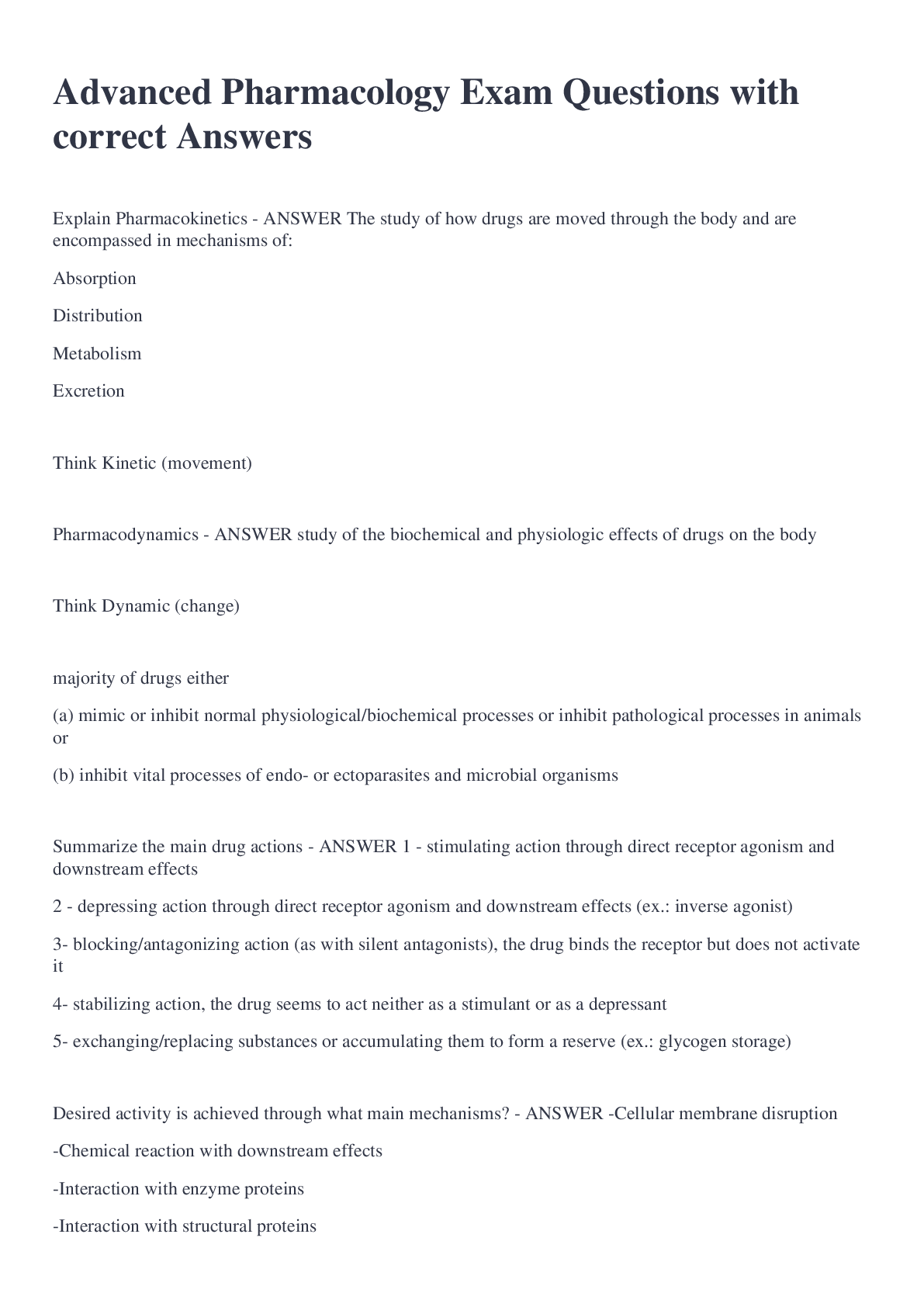
Buy this document to get the full access instantly
Instant Download Access after purchase
Buy NowInstant download
We Accept:

Reviews( 0 )
$8.00
Can't find what you want? Try our AI powered Search
Document information
Connected school, study & course
About the document
Uploaded On
Aug 20, 2022
Number of pages
52
Written in
Additional information
This document has been written for:
Uploaded
Aug 20, 2022
Downloads
0
Views
71


